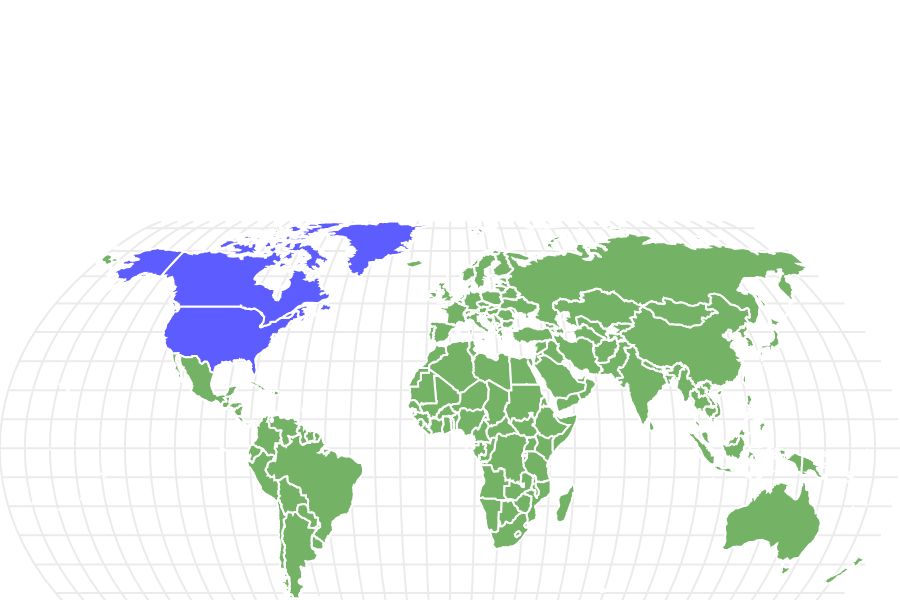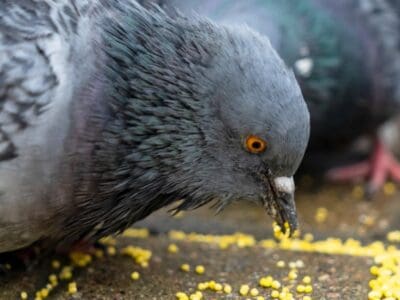Largest mammal in North America!
Advertisement
Bison Scientific Classification
- Kingdom
- Animalia
- Phylum
- Chordata
- Class
- Mammalia
- Order
- Artiodactyla
- Family
- Bovidae
- Genus
- Bison
- Scientific Name
- Bison Bison
Read our Complete Guide to Classification of Animals.
Bison Conservation Status
Bison Facts
- Main Prey
- Grass, Acorns, Berries
- Distinctive Feature
- Huge head and a shoulder hump
- Habitat
- Grass plains and forest
- Predators
- Human, Bear, Wolves
- Diet
- Herbivore
The Largest Land Mammal in North America
With their gigantic heads, massive horns, and shaggy fur, bison are the largest mammal in North America and have long dazzled the imaginations of native peoples and American settlers.

At the start of the 1800s, about 60 million bison roamed the forests, plains, and river valleys from Alaska to Mexico. By 1889, only about 635 remained in the wild leading President Roosevelt’s administration to add them to the protected species list. Today, thanks to educational and re-population efforts, wild bison numbers have swelled to about 20,500. They are considered “one of the greatest conservation success stories of all time.”
Four Interesting Facts About Bison
- Large and in Charge: Bison, which are technically a type of cow, are the largest terrestrial mammals in North America. But don’t let their lumbering size fool you. Bison can reach running speeds of 40 miles per hour!
- Official Status: Bison is the official national mammal of the United States, and November 1st is National Bison Day.
- Cross-Breeding with Cows: Ranchers breed bison with cows, and the resulting animals are known as “beefalo” and “zubron.”
- Singular and Plural: Bison is one of the few words in the English language where the singular and plural forms of the word are the same.
Scientific and Cultural Names
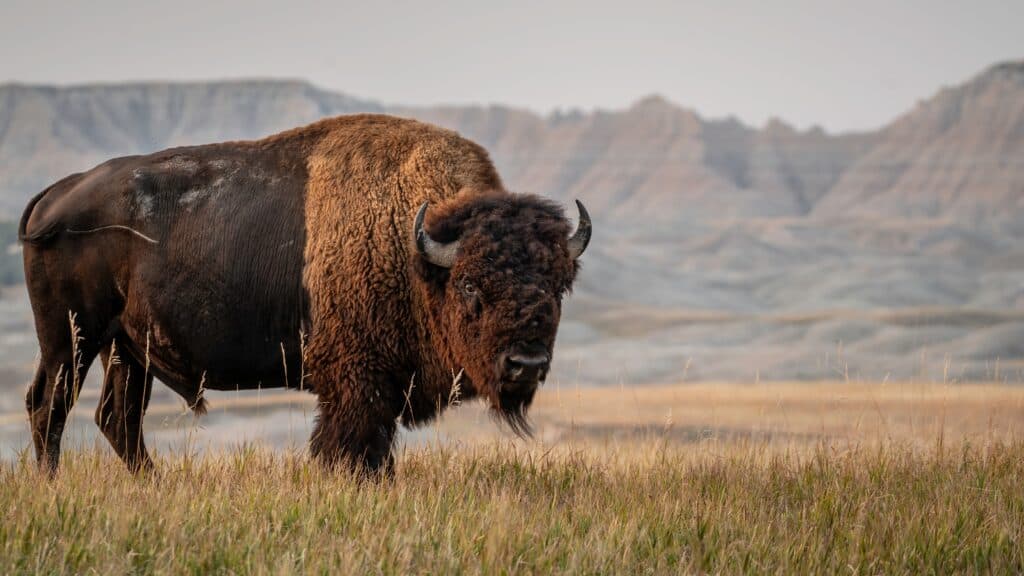
Tatanka is the Siouan word for bison, which translates to “big beast.”
©Tim Malek/Shutterstock.com
The word “bison,” which means “wild ox,” has Latin, Proto-Germanic, and Middle English linguistic roots.
You may hear people call bison “buffalo” or “American buffalo.” Though common, it’s a bit of a misnomer because bison are a far-distant relative to actual buffalo and water buffalo that live in Africa and Asia. French Explorer Samuel de Champlain is thought to be the person who mistakenly labeled bison as buffalo when adventuring across North America in the 18th century.
In Europe, bison are also known as wisent. Though linguists aren’t 100 percent positive about the word’s roots, most agree it stems from a Slavic or Baltic term meaning “the stinking animal.”
In Siouan languages, spoken by Lakota and Sioux peoples, the word for bison is “tatanka,” which translates to “he who owns us” or “big beast.”
Species
American Bison (Bison bison bison)
There are two types of bison. The first carries the scientific name Bison bison bison, and they live primarily in North America – in scrubland and river valleys. They are covered in hair except for a less hairy tail and have large horns that point upwards and sideways. They weigh between 800 – 2,800 pounds and can stand as high as 6 ft 7 in at the shoulder. American bison are easier to tame than their European counterparts and can be bred with cattle. American bison can be divided into two sub-species – the plains bison (B. bison bison) and the wood bison (B. bison athabascae).
European Bison (Bison bison bonasus)
The second type is known scientifically as Bison bison bonasus, and they live mainly in Europe. These bison are less hairy than American bison, although their tails are hairier. Weighing between 935 – 2,030 pounds and standing up to 6 ft 11 in at the shoulder, European bison are a little smaller than American bison. With forward-pointing horns and an ornery disposition, European bison are more difficult to tame.
Evolution
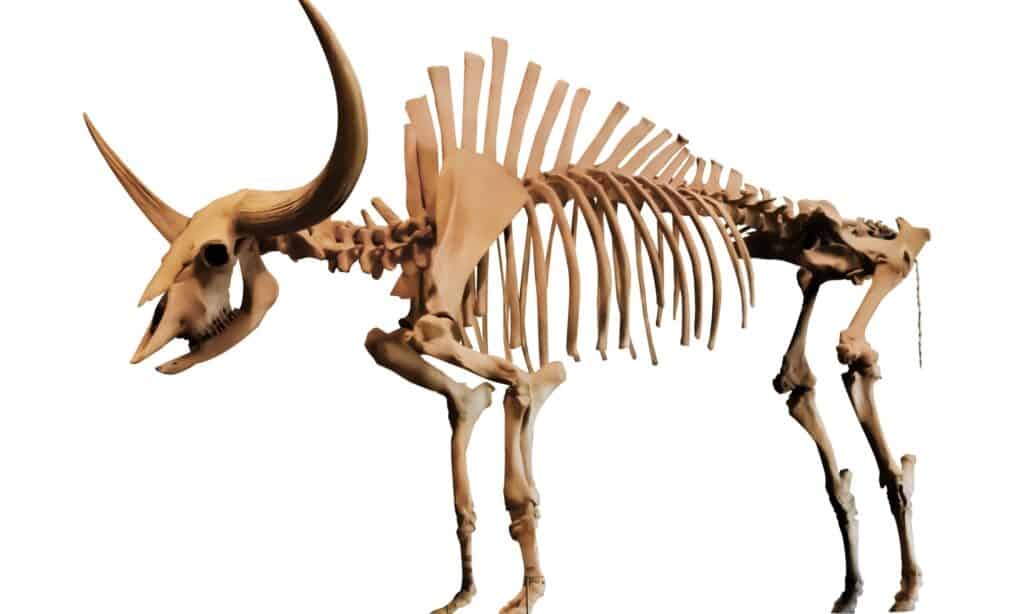
Bison
latifronslived in North America during the Pleistocene epoch and was the largest bovid to ever live in North America.
©iStock.com/barbaraaaa
North American bison are part of the Bovini group which includes cattle, yaks, zebu, wiset (the European bison), and gaur. Although relationships between species are complicated and unresolved, it is agreed that the closest ancient ancestor of the bison is bison antiquus.
The bison genus first appeared in southern Asia around 2 million years ago. Bison priscus lived in northern Eurasia and Alaska and may have been the dominant hoofed mammal during their time. These animals immigrated to North America during the Pleistocene Epoch(240,000 – 220,000 years ago) by way of the Bering land bridge during times of low sea levels.
Bison latifrons evolved from B. priscus with the former leading to bison antiquus. The last appearance of bison antiquus in North America was around 10,000 years ago. These animals led to the modern American Plains Bison.
Bison Appearance
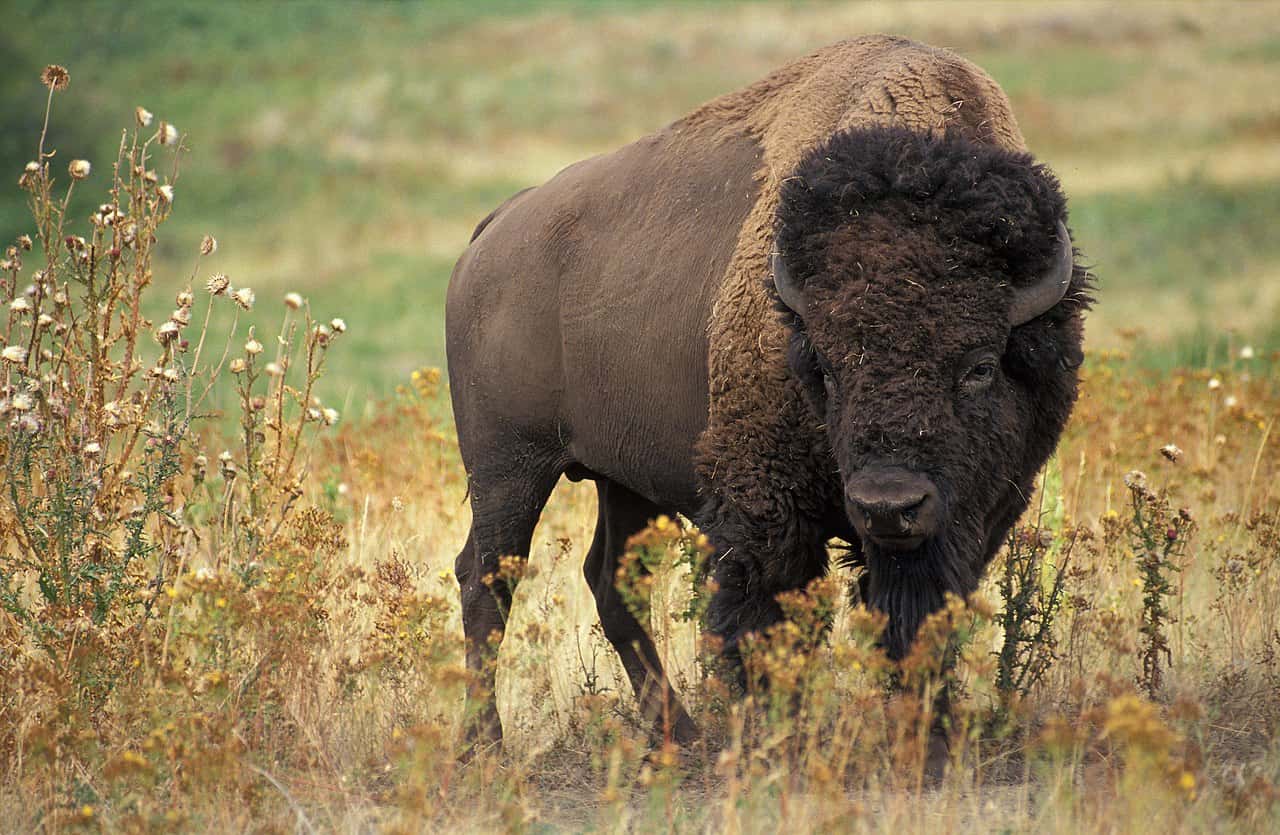
Bison are enormous animals with two large horns.
The average adult found in North America is two meters — or 6 feet 2 inches — tall. That’s taller than basketball legend Michal Jordan! Lengthwise, they can reach 3 meters, which is 11 feet. European bison are slightly taller but squatter, measuring 2.1 meters — or 6 feet 11 inches — tall and 2.9 meters — or 9 feet 6 inches — long.
When it comes to weight, American bison tip the scales between 400 and 1,270 kilograms, which calculates to about 880 and 2,800 pounds. European bison typically fall between 800 and 1,000 kilograms, or 1,800 to 2,200 pounds. To put it another way, bison weigh about as much as a car.
Cold-weather bison sport long and shaggy hair. Ones that live in warmer climates have shorter fur. When born, bison are a red-orange color. At around two months old, the red starts turning into dark brown. In colder months, bison grow thicker fur coats that they shed in the summer months.
Bison fall into the artiodactyl category of animals, meaning they have cloven hooves. And though they are huge animals, they’re also fast and can reach speeds up to 40 miles per hour. As a comparison, the average human runs between 8 and 10 miles per hour. Elite athletes, like marathon superstar Eliud Kipchoge, run at about 13 miles per hour.
American Bison v. European Bison
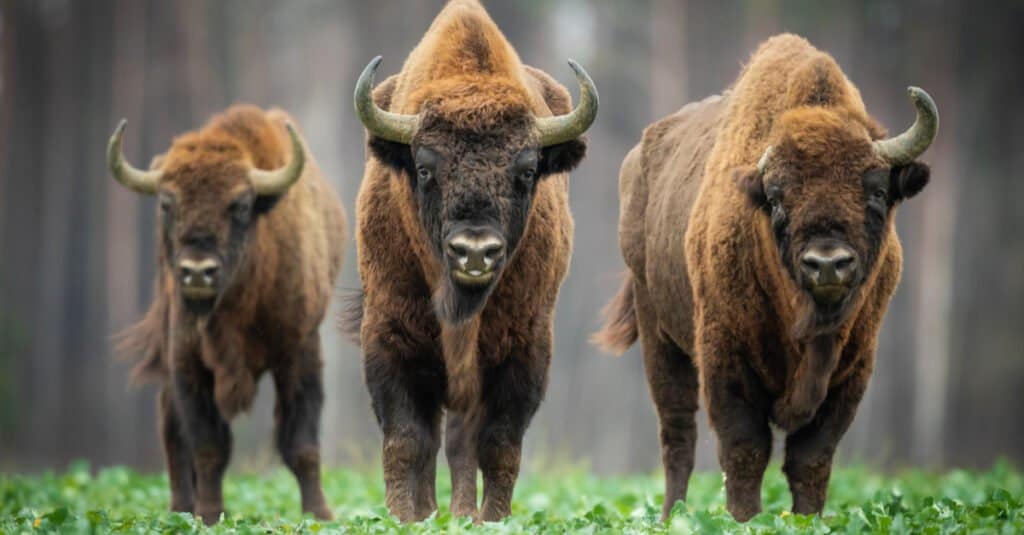
European bison lack the shaggy fur around their heads and necks of American bison.
©Szczepan Klejbuk/Shutterstock.com
The American and European bison are very similar animals but do have a few small differences.
For starters, American and European bison are animals that live in slightly different habitats. The former tend to roam in open plains and mountain regions while the latter congregate in woody forests. Behaviorally, American plains bison are easier to domesticate than European wood bison.
Additionally, American bison fur is typically longer than its European counterpart. However, European bison’s tails are hairier than American bison’s tails. Additionally, American bison tend to graze and eat low-lying vegetation and grass. European ones, on the other hand, are browsers, which means they feed mostly on leaves, shoots, and hanging fruits.
European and American bison also have small anatomical differences. American ones have 15 ribs and European ones have only 14. American buffalo has four lower spine discs while their European counterparts have five. Lastly, European bison have slightly longer legs and necks than their American cousins.
Largest Bison Ever
In 2007, a hunter in Wyoming’s Bridger-Teton National Forest killed an area bison known as “Old Lonesome,” who was believed to have the largest recorded horns of the species. From tip to tip, Old Lonesome’s horns measured 32 inches. Individually, each horn was about 19 inches.
Today, cattle farmers raise bison for meat. The largest recorded one weighed in at 3,801 pounds or 1,724 kilograms. The heaviest wild bison ever recorded weighed 2,800 pounds or 1,270 kilograms.
Behavior
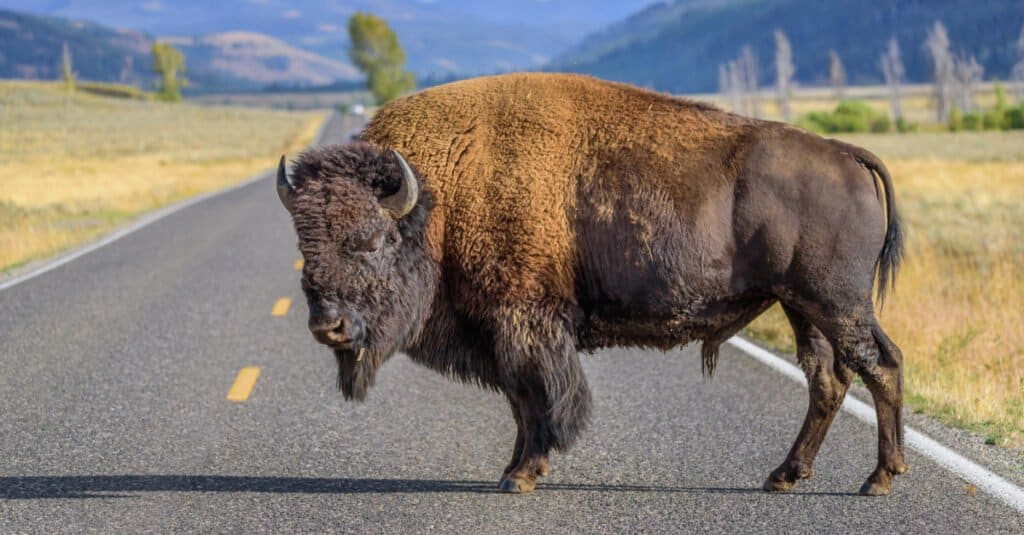
American bison are easier to tame than their European counterparts.
©iStock.com/IngerEriksen
At times bison are peaceful and lazy. Other times, they can be bold and dangerous without warning. Mothers grow especially protective if they sense a threat near their calves. Humans should not get closer than 25 feet to bison at a minimum.
Bison generally live in gender-specific herds for part of the year. When male bison — or bulls — reach two years old, they leave their mothers and join a male pack called a “bachelor herd.” Female herds are usually larger than male ones and have a matriarch that makes the big decisions, like where to graze and when to sleep. Every year, female and male herds join up for the mating season.
Bison like to wallow. No, that doesn’t mean they sit around feeling sorry for themselves. Wallowing is when animals roll around in mud, water, or dust. They engage in this behavior for several reasons. Sometimes they use wallowing as an astringent to soothe their skin or as a temperature control tool. Other times they do it for fun and to attract partners during mating season. Wallowing, however, can prove fatal to bison if they do it in a spot infected with anthrax spores.
Habitat
Today, wild bison live in North America, and Europe, and a small herd roam in Russia. In North America, herds mostly stick to the Great Plains west of the Mississippi River and tall-grass plains and east of the Rocky Mountains.

Yellowstone’s bison herd are ancestors of original native animals.
©Michael Hinkle/Shutterstock.com
Purebred American buffalo herds live in the following regions:
- Yellowstone National Park in Wyoming and small sections of Utah and Idaho
- Wind Cave National Park in South Dakota
- Blue Mounds State Park in Minnesota
- Elk Island National Park in Alberta
- Grasslands National Park in Saskatchewan
- The Henry Mountains in Utah
European bison mainly live in wooded areas.
Diet: What Do Bison Eat?
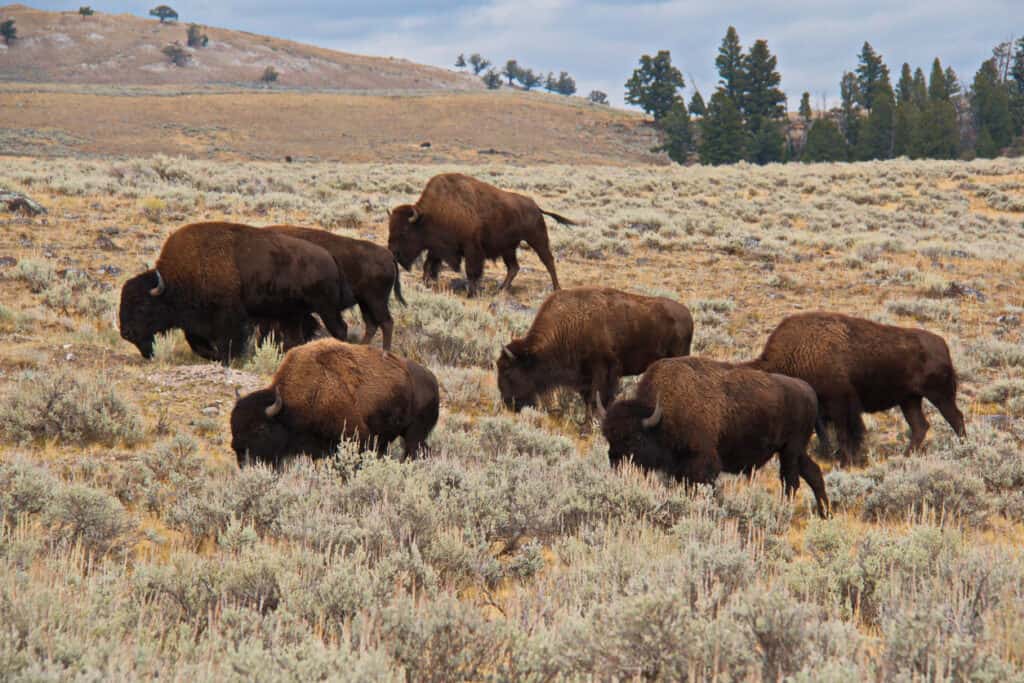
A bison’s diet consists of 93% grass.
©iStock.com/Karel Stipek
American Bison are nomadic vegetarians. Their diet consists of 93 percent grass, 5 percent flowering shrubs, and 2 percent vegetation that hangs from trees. To remain healthy, bison must eat 1.6 percent of their body mass per day, which averages to about 24 pounds of daily vegetation — or two bowling balls worth of grass and plants!
Bison migrate with the vegetation and go where the most nutritious options grow based on the time of year. Like other livestock, they need to avoid toxic plants, like hemlock, arrowgrass, death camas, and milk vetch.
Bison have a ruminant digestive system, meaning they can ferment and isolate nutrients in a special compartment in their stomachs.
Predators and Threats
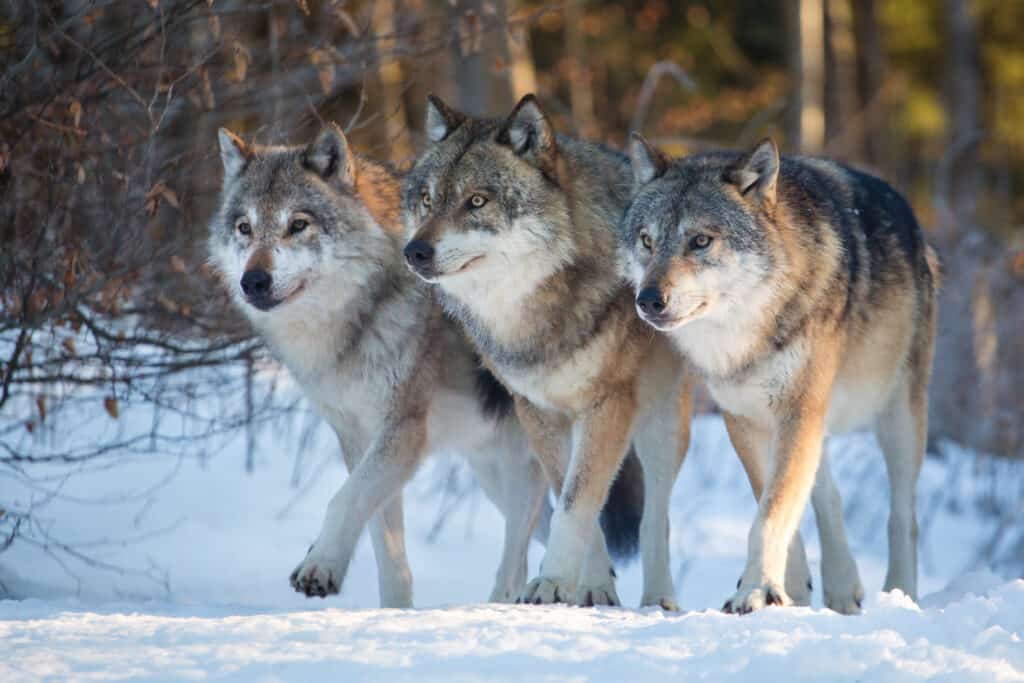
Wolves prey on bison.
©David Dirga/Shutterstock.com
Wolves, cougars, bears, and humans hunt and prey on bison.
In North America, before the 1800s, native tribes responsibly hunted bison for sustenance. They used nearly every part of the animal to support entire communities. When settlers started heading west, several factors decimated the bison population. Technological advances, like railroads, mines, and factories, encroached on bison’s habitats and introduced diseases that proved fatal to the species. Collectively, the events are known as “the great bison slaughter of the 19th century.”
So that raises the question: Are bison endangered? The answer depends on the region.
Though bison were once a protected species in the United States, they are no longer rated that way. However, organizations like the Buffalo Field Campaign maintain lobbying efforts to get them added to the list. Additionally, the World Wildlife Foundation and International Union for Conservation of Nature list bison as “near threatened.”
Unlike the United States, Canada lists wood bison on its endangered list.
Reproduction, Babies, and Lifespan
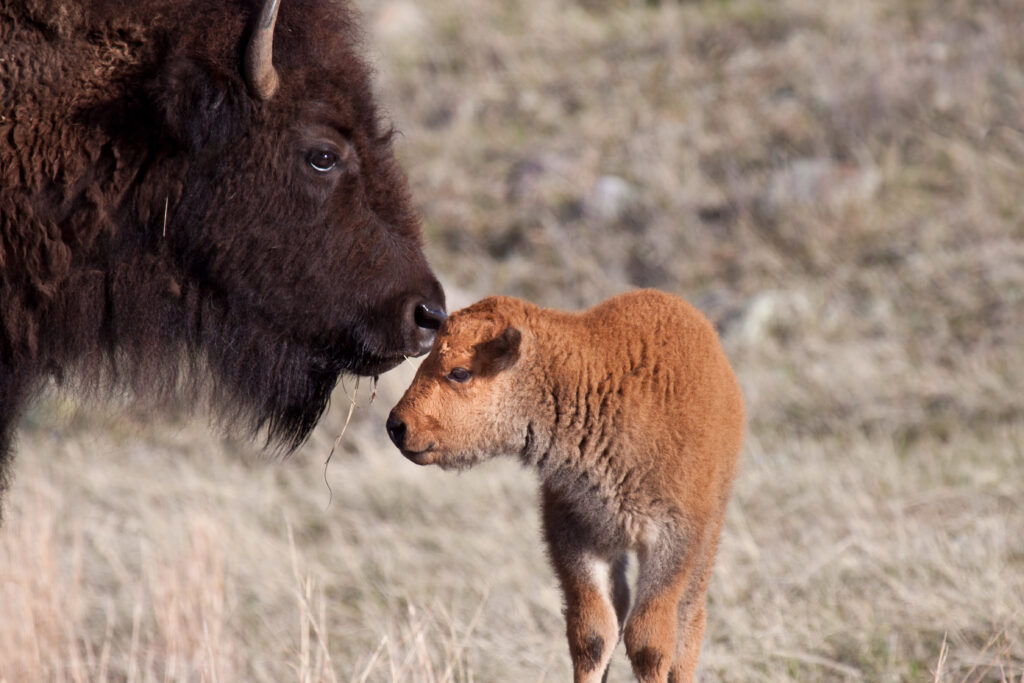
Bison calves are born with red coats.
©Marcia Straub/Shutterstock.com
Mating
Bison mating season is called “rutting season” or “the rut.” It kicks off in June and ends in September. As mammals, female bison — called “cows” — have live births and gestate for about 285 days, which is about the same as humans. They’ve got it easier than elephants, though, who remain pregnant for nearly two years. Also, like people, bison typically only have one child at a time, but twins do happen occasionally. Unlike humans, bison babies weigh a whopping 30 to 70 pounds or 14 to 32 kilograms.
To attract mates, bulls bellow and wallow, meaning they let out loud cries and roll around. They also headbutt and charge at each other as a show of strength to protect their ladies. Notice we didn’t say “lady.” That’s because bison are polygamous, meaning one male mate with several females, but females only mate with one male.
Bison can reproduce between the ages of 3 and 19. Cows who get pregnant after 8 years old are considered to have geriatric pregnancies.
Baby Bison Facts
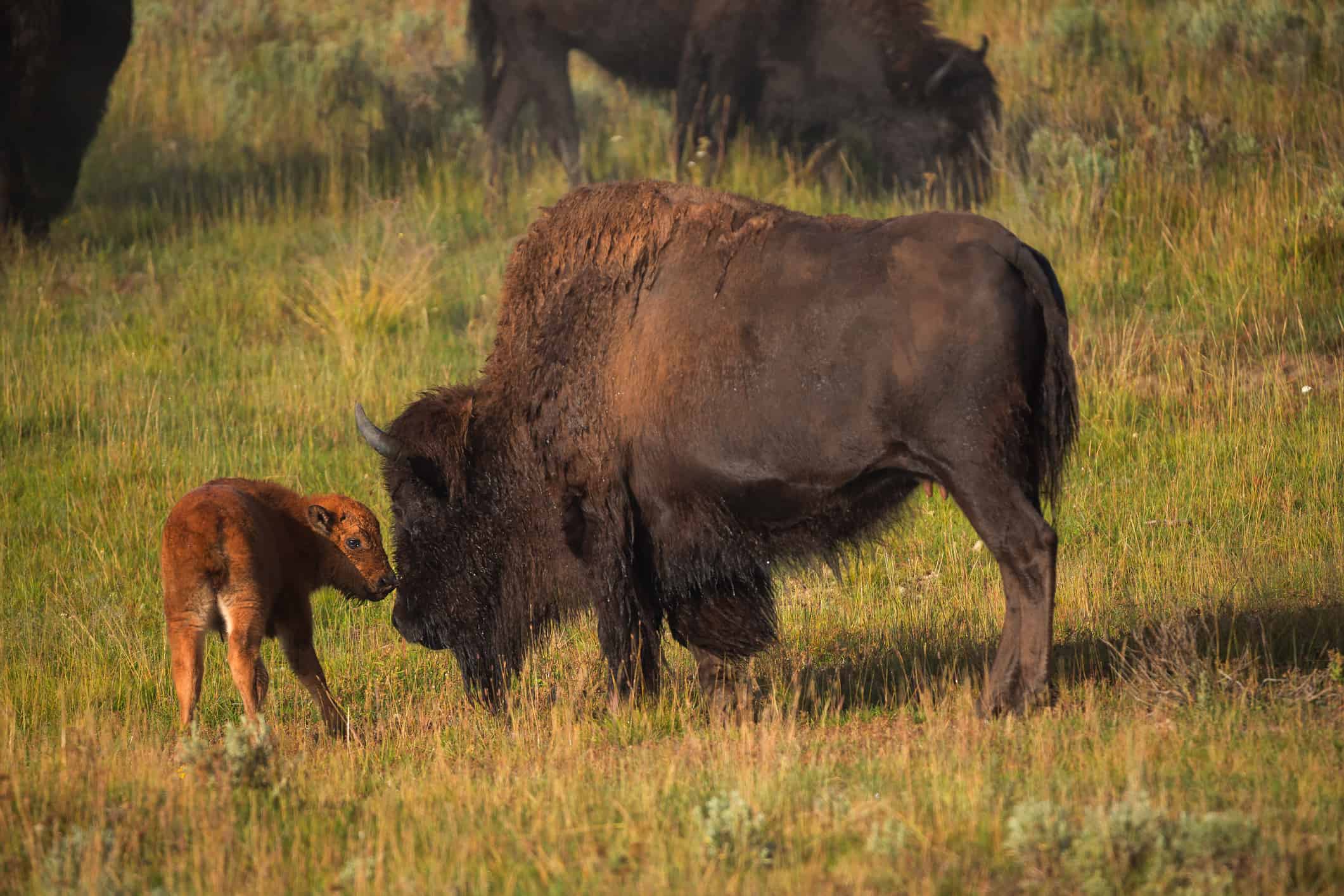
Bison calves stay with their mothers for two to three years.
©iStock.com/Bill_Vorasate
Technically, a baby bison is a calf, but they’re commonly called “red dogs” because of their orange-reddish fur at birth. In their early months, mother cows produce milk for their babies and teach them how to graze for vegetation. Little ones typically stay with their mother’s herd for between two and three years before joining a bachelor herd.
Lifespan
Wild bison have a lifespan of about 15 years; captive bison can live to about 25.
Population

Thanks to conservation efforts, bison have gone from near extinction to a population of over 500,000.
©Ricardo Reitmeyer/Shutterstock.com
During the 1800s, westward expansion and overzealous hunting reduced the bison population close to extinction in North America. As entertainment, some train companies offered hunting-by-rail trips where men would stand atop rail cars and shoot bison. Today, thanks to education and conservation efforts, about 20,500 wild purebred bison and 500,000 bison-cattle hybrids call the United States and Canada home. About 600 bison live in Europe and a small section of Russia.
Interestingly, the 1986 Chornobyl disaster played a role in the recent resurgence of wisents in Europe. After the nuclear disaster in the region, officials created the Chornobyl Exclusion Zone, which has turned into a makeshift wildlife preserve. The vegetation that now grows in the area proved beneficial to large mammals and has supported the regeneration of European bison and brown bears.
In the United States, in 1913, bison re-population efforts were aided by the New York Zoological Park — now known as the Bronx Zoo. As a gift to the federal government, the zoo put 14 bison on a train west to the Black Hills of South Dakota. From there, they were loaded onto another train and let loose in the plains. Those 14 American buffalo are the ancestors of the bison that now roam in Yellowstone National Park.
Bison FAQs (Frequently Asked Questions)
Are bison called ox?
No, the main difference that separates bison vs. ox is that bison are two distinct species that live in North America and Europe while ‘ox’ is a term generally used to refer to castrated male cows.
What are the differences between bison and moose
The key difference between bison and moose is in their body appearance. While both are large land mammals that live in North America and Eurasia, buffalo are much stockier while moose are members of the deer family and have much longer legs.
Are bison carnivores, herbivores, or omnivores?
Bison are herbivores that only eat plants and vegetation.
What’s the difference between American and European Bison?
The American and European bison are similar but have a few small differences. The former live in open plains and mountain regions; the latter hang out in woody forests. The two subspecies also have slight anatomical differences. For example, American bison usually have longer hair than European ones, and the former has one more rib than the latter.
Is a bison a buffalo?
Though bison and buffalo are different species, many people call American bison buffalo. It’s such a common term that the United States issued a “buffalo nickel” in 1913.
What Kingdom do Bison belong to?
Bison belong to the Kingdom Animalia.
What phylum do Bison belong to?
Bison belong to the phylum Chordata.
What class do Bison belong to?
Bison belong to the class Mammalia.
What family do Bison belong to?
Bison belong to the family Bovidae.
What order do Bison belong to?
Bison belong to the order Artiodactyla.
What genus do Bison belong to?
Bison belong to the genus Bison.
What type of covering do Bison have?
Bison are covered in Hair.
In what type of habitat do Bison live?
Bison live in grass plains and forests.
What do Bison eat?
Bison eat grass, acorns, and berries.
What are some predators of Bison?
Predators of Bison include humans, bears, and wolves.
What are some distinguishing features of Bison?
Bison have huge heads and a shoulder hump.
How many babies do Bison have?
The average number of babies a Bison has is 1.
What is an interesting fact about Bison?
Bison are the largest mammal in North America!
What is the scientific name for the Bison?
The scientific name for the Bison is Bison Bison.
What is the lifespan of a Bison?
Bison can live for 15 to 20 years.
How fast is a Bison?
A Bison can travel at speeds of up to 22 miles per hour.
What's the difference between a yak and a bison?
There are many differences between bisons and yaks. Yaks live at much higher elevations than bison do and have much longer fur and tails compared to bison.
Are American bison extinct?
No, American bison are not extinct.
What are the differences between muskox and bison?
The main differences between a muskox and a bison are their size, preferred habitat, and evolutionary history.
How to say Bison in ...
Thank you for reading! Have some feedback for us? Contact the AZ Animals editorial team.
Sources
- David Burnie, Dorling Kindersley (2011) Animal, The Definitive Visual Guide To The World's Wildlife
- Tom Jackson, Lorenz Books (2007) The World Encyclopedia Of Animals
- David Burnie, Kingfisher (2011) The Kingfisher Animal Encyclopedia
- Richard Mackay, University of California Press (2009) The Atlas Of Endangered Species
- David Burnie, Dorling Kindersley (2008) Illustrated Encyclopedia Of Animals
- Dorling Kindersley (2006) Dorling Kindersley Encyclopedia Of Animals
- David W. Macdonald, Oxford University Press (2010) The Encyclopedia Of Mammals

